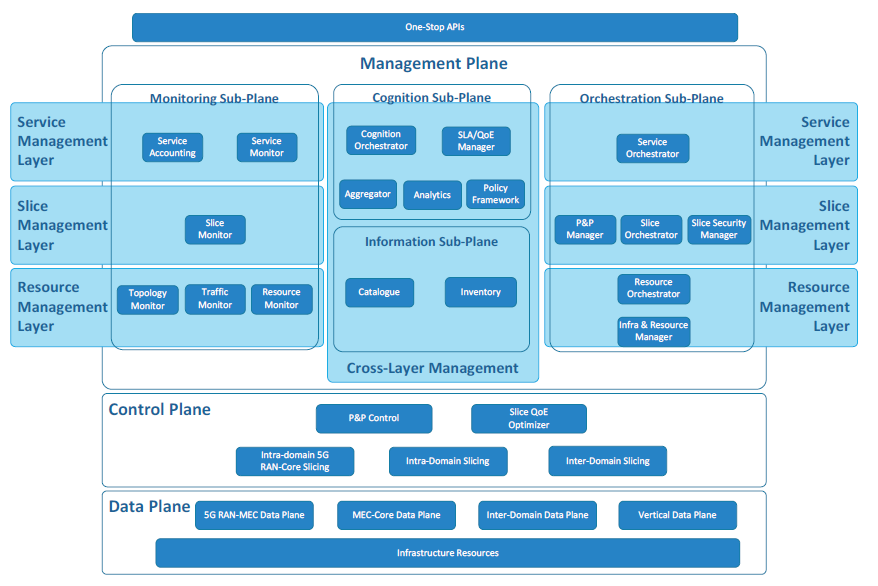One of the key, innovative, SliceNet elements is the deployment of a slicing-friendly infrastructure for an efficient, low-cost, fast deployment and provisioning of a specific vertical slice through software-networking 5G proof-of-concepts. It investigates the mechanism and tools for a software programmable infrastructure, aware of QoS and QoE and enhanced control.
SliceNet firstly propose an overall architecture related to the main principles of Network Slicing, Plug & Play component, One-Stop-API, Cognition and Cross-plane and Multi-domain orchestration. The SliceNet architecture is deconstructed here into three main logical components:
- Control plane, including P&P control and Slice QoE optimizer
- Management plane, including service, slice and resource management layer
- Data plane, including infrastructure resources, RAN-MEC-Core and inter-domain forwarding plane
Control Plane (CP) defines the slice and details the main components of SliceNet CP, P&P and QoE components, along with the SliceNet interfaces and APIs. Also defined are the inter-domain and intra-domain slicing concepts and workflows, at the same time as the data plane programmability for QoS aware slicing and resources control. The CP enabler components are introduced here. Also the End-to-End slice runtime customization (P&P) and network metrics monitoring and optimizer (QoE optimizer) that assures the vertical SLA, by defining two level of abstraction:
(1) southbound interfaces of CP that provide information for the infrastructure and
(2) P&P and QoE optimizer, as enablers that are using Software Defined Network(SDN) and Network Function Virtualization(NFV) technologies for service functioning within a slice.
The proposed work flow diagram provides the slice configuration in terms of KPIs collection, slice VNF configuration and slice VNF deployment.
Management plane (MP) defines the specificity of the end-to-end network slicing management and orchestration in context of 5G networks. This includes the slice information model, cognition based modules, machine learning enabled management, QoS and QoE awareness, relation between the service, slice, network operators and vertical users and stakeholders. It also defines the roles of the Digital Service Customer(DSC), Digital Service Provider(DSP) and Network Service Provider(NSP) and their responsibilities. The DSC is in charge of consuming the offered digital services, the DSP manages and exposes digital services as well as monitoring and orchestrating the service. The NSP exposes the network infrastructure services and maintains the relationship with the DSP, including monitoring, inventory, orchestration and analytics capabilities.
In addition, one of the key requirements of the SliceNet management and control plane architecture is to support a variety of vertical industries such as those proposed i.e. smart grid, e-health and smart city, and is aligned with other architectures proposed by standardizations and widely referenced in the academic research and other collaborative projects.

